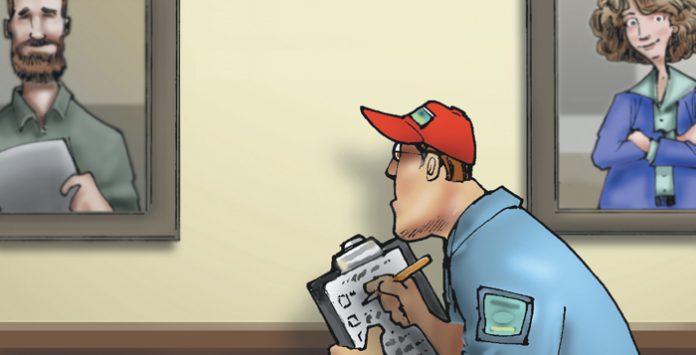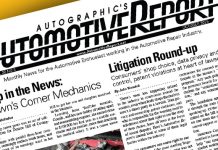By John Yoswick
As you’ve considered what health insurance to buy for you and your family, have you ever checked with friends or others you know in healthcare to see what their experience has been working with various medical insurance providers? Who else would know better which insurers press hardest for cost-containment, and which seem to put the most emphasis on quality of care?
There’s a similar concept behind a new annual “Insurer Report Card” that asks collision repair shops to grade auto insurers.
“Most consumers are lucky enough to go years — in fact, a decade, on average — without a need to contact their insurer’s claims operation,” said Chuck Cogan of CRASH Network, a weekly subscription newsletter in the industry that conducted the study, and for which this writer is an editor. “But collision repairers interact with these companies every day. We think their perspective on which companies do the best job taking care of policyholders — and which ones have some room for improvement — can be a valuable tool for drivers as they consider which insurer to choose.”
The latest “Insurer Report Card” study is going on now during the month of November, and shops can visit https://www.CrashNetwork.com/gradebook to participate. But the findings of the initial study, conducted late last year, were released earlier this year. More than 1,200 individual shops around the country participated, each grading as many as 30 different insurance companies in their state on a scale from “A+” to “F” in terms of how well each company’s “policies, attitude and payment practices ensure quality repairs and customer service for motorists.”
“Shops on a daily basis see first-hand how those companies take care of customers after an accident,” Cogan said. “They know, for example, which insurers pressure them to use the cheapest parts, which refuse to pay for repair procedures needed to ensure a high quality repair, or which add unnecessary delays to the whole repair and claims process.”
One interesting trend among the results: Smaller, lesser-known insurers received the highest marks from collision repairers grading the auto insurers’ claims practices.
“Many consumers won’t have seen or heard advertisement after advertisement for North Carolina Farm Bureau, Grinnell Mutual or Acuity Insurance, but shops graded these companies as among the best when it comes to taking care of customers after a claim,” Cogan said. “You have to look fairly far down the rankings before you find one of the best-known and largest auto insurers, but most consumers will find an insurer or two among the 15 highest-graded who offer auto insurance policies in their state.”
Judging by the more than 10,000 comments collision repair professionals submitted while grading the insurers, there are several key traits that the high-scoring insurers have in common. Among the top-five insurers, for example, repairers repeatedly used phrases such as, “cares for the customer,” “quality repair,” “easy to work with,” “fast response,” and “hassle-free.”
One repairer, for example, noted about Mutual of Enumclaw (ranked No. 4 in the nation), “They ask us only to repair the vehicle as if it were our own, and in a timely manner. This company trusts us to take care of their needs, while taking care of the customer’s needs as well.”
Collision repair professionals had an equal number of comments about the insurers they rated poorly, and those, too, have many themes in common. Repairers often used phrases such as, “does not care about the quality of the repair,” “pushes us to use cheapest/lowest quality parts available,” “does not follow manufacturer repair specifications,” “hard to deal with,” “inexperienced adjusters,” and “only cares about cost.”
Commenting on one of the lowest-ranked insurers, one repairer wrote, “Adjusters never answer the phone. [They push for] all aftermarket parts on all cars, even [newer vehicles] with less than 2,000 miles, and do not pay for necessary procedures to properly repair a vehicle.”
Among the five largest auto insurers in the United States, only two – USAA (ranked No. 42) and State Farm (ranked No. 47) – were among the top 50 in this year’s survey rankings. The second-largest auto insurer in the country, GEICO, was ranked No. 76, an indication that in the view of collision repairers regularly interacting with these companies, there are 75 other insurers offering superior claims service for policyholders and their vehicles following an accident.
It might be tempting to presume regional insurers would do better in the survey because fewer shops were grading their performance. But the results don’t bear that out. Two of the top-graded insurers received those grades from a significant number of shops; Erie Insurance was graded by 352 repair facilities, and Cincinnati Insurance received grades from 274 facilities. Grading by fewer shops was also no guarantee of a higher ranking; Loya, one of the worst performers in this year’s “Insurance Report Card,” was graded by 136 facilities.
There also were some variations between states. Allstate was graded above average (“B-”) by shops in Texas and Missouri, for example, but got an abysmal grade of “D+” from shops in Indiana and Massachusetts. Similarly, Progressive got a solid “B” from shops in Minnesota, but a “D” from shops in New Jersey. Liberty Mutual/Safeco earned a “B-” from Florida shops, but a “D+” in Massachusetts. And New York and Texas shops awarded Farmers a “B-,” much higher than the “D+” that insurer earned from New Jersey shops.
In addition to assigning a grade for each insurer, respondents also indicated whether or not they participate in that insurer’s direct repair program. Perhaps not surprisingly, repair facilities tended to give higher grades to those insurers with which they have a DRP relationship. For the Big 10 largest insurers nationally, their DRP facilities awarded them, on average, two-thirds of a grade higher than non-DRP shops awarded the same insurer.
State Farm was a stand-out here, with its DRP shops giving State Farm a full one-letter grade higher than did shops that are not part of State Farm’s DRP. American Family stood out here for a different reason: Its DRP shops gave that insurer a “C,” no better a grade than did shops that aren’t part of American Family’s DRP.
Travelers grabbed the top spot from USAA among the 10 largest insurers when looking only at the grades given to each by shops that are not part of that insurer’s DRP. Shops outside of Travelers’ DRP gave the company a “B-” compared to USAA’s “C+”. Nationwide finished third (“C+”) among the largest insurers in terms of shops not in its DRP, and State Farm finished fourth (“C”).
The “Insurer Report Card” results certainly shouldn’t be a consumer’s lone source of information in choosing an auto insurer. But they can introduce those consumers to some smaller but high-graded insurers they may not have previously considered. And the findings may synch up with other sources of information on insurers as well. Erie Insurance, ranked No. 8 in the nation, was also the second-highest ranked insurer in J.D. Power’s 2016 U.S. Auto Claims Satisfaction survey of about 12,000 consumers who’d settled an auto insurance claim within the previous six months. Auto-Owners Insurance and Amica both received a “B” on the “Insurer Report Card” and were also ranked among the Top 5 in the J.D. Power survey.
Among large national insurers, USAA was the top-ranked insurer in not only the “Insurer Report Card” but also the J.D. Power survey and in a 2017 Insure.com survey of more than 3,700 consumers.
Another source drivers can use in choosing an auto insurer is the consumer complaint records maintained by their state’s insurance regulatory agency. Again, there’s anecdotal evidence that collision repairers’ views of auto insurers may synch up with what state insurance commissioners are hearing from consumers.
In New York, for example, collision repair shops gave Chubb the highest grade of any insurer in that state, and 2015 records from the New York Department of Insurance (the latest available) show that Chubb had a complaint ratio of zero (higher complaint ratios indicate a higher number of complaints compared to the amount of business that insurer des in the state). Country-Wide Insurance finished last on the “Insurer Report Card” in New York, with a grade of “D,” and the state insurance commissioner lists a complaint ratio of .511 for that company, the worst among the 22 insurers that were graded by shops in that state.
Similarly in Texas, shops gave Chubb and Amica the highest grades, and their complaint ratios for 2016 with the Texas Department of Insurance are among the best (Chubb had no complaints, and Amica only one). Texas insurance regulators say a “complaint index” above 1.0 is worse than average, and the five insurers with the lowest grades in the “Insurer Report Card” for Texas all had complaint ratios above 2.0. ACCC Insurance and Loya each got a “D+” grade from collision repairers, for example, and had 61 and 43 consumer complaints, respectively, putting their complaint indexes with the state agency above 3.0.
It also can be instructive to watch an insurers’ grade over time, something that the “Insurer Report Card” will be able to begin to do next year when the 2018 results are released. But in the meantime, Oregon shops have been similarly grading insurers in their state for more than a decade. There, Oregon Mutual (ranked #6 in the country on the “Insurer Report Card”) has consistently been at the top of the list with a “B+,” and Geico has consistently received a below-average “C-” year after year. Travelers’ grade has fallen a bit, from a “B-” in 2011 and 2013 to a “C” this year.
But two insurers have improved their grades over time in Oregon. Farmers has risen somewhat from a “D+” in 2013, to a “C-“ in 2015, and to a straight “C” in Oregon on the 2017 “Insurer Report Card.” Progressive has racked up an even a bigger improvement, from a dismal “D+” in 2009 to a “B-” among Oregon shops this year.
“Just as medical providers see how health insurers process claims, collision repair shops interact with auto insurers on a daily basis, so we feel it’s worthwhile to ask their opinion on how well those insurers treat car owners after an accident,” Cogan said. “We believe their views will be enlightening to insurance companies and consumers.”
A free executive summary of the 2017 “Insurer Report Card” findings can be downloaded at https://www.crashnetwork.com/irc. •
John Yoswick, a freelance writer based in Portland, Ore., who has been writing about the automotive industry since 1988, is also the editor of the weekly CRASH Network bulletin (www.CrashNetwork.com). He can be contacted by email at john@CrashNetwork.com.



